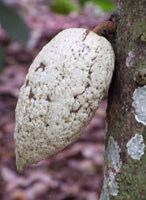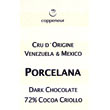 FLAVOR PROFILE: Naked; high chocolarity (pure-flavored, even-keeled cocoa) & buttery macadamia; berries ‘n cream; sometimes breaded flavors & delicate spice.
FLAVOR PROFILE: Naked; high chocolarity (pure-flavored, even-keeled cocoa) & buttery macadamia; berries ‘n cream; sometimes breaded flavors & delicate spice.
CHARACTERISTICS: translucent chocolate from smooth pods colored pale green to white (attributable to lacking the flavonoid anthocyanin which is usually purple) & light pinkish seeds, reflected in the name, ‘porcelain’ in English; exceedingly delicate, finesse over power; least acidic / fruited of fine cacáos; low astringency & bitterness requiring very light roasting.
The Holy Grail of Cacáo; among rarest & most expensive of all beans in the world. As genetically pure as Criollo commercially gets, nearly a monoseed. Exclusive mostly to small fields south of Lake Maracaibo, Venezuela in the Catatumbo flood plain (centered around El Chama Estate belonging to Corpozulia, located in the Km 41 of Santa Barbara Road, El Vigia, Colon municipality, Zulia state), or farther west along the northern coast of Colombia between Dibulla & the suburbs of Santa Marta. (Porcelana stands are also cited in the very center of fabled Xoconochco, Mexico at Izapa, growing among ruins there, as well as in Peru.)
Raffaele & Fiorella Ciferri in The Evolution of Cultivated Cacao argue that what they term ‘Porcelain’ (i.e., Porcelana) is possibly an albino mutant of an Amazon Calabacillo.
The Genetic Improvement of Cacao edited by L.A.S. Dias elaborates on wild Amazon cacáo in Brazil sporting white cotyledons, classified as mutants preserved by humans & variously designated as Catongo & ‘Almeida’. It speculates that at the outset in its primitive beginnings, all cacáo may have borne white seeds in view that its cousin species within the Theobroma genus (Grandiflorum, Bicolor, etc.) do today. Over time an evolution toward seeds of purple color might have conferred adaptive advantage due to protective properties of the acquired anthocyanin pigment gene responsible for darker-colored seeds because they tend to be bitter so predators such as monkeys would thus spit them out & thereby help propagate cacáo.
Geneticist Dapeng Zhang explains how purple vs. white is controlled by the anthocyanin biosynthetic pathway. The pathway involves several steps, each managed by more than one structural or regulatory gene. These genes work together to produce several important enzymes that are essential for the pathway to function properly.
Since the pathway needs several enzymes to work collaboratively, sometimes a single gene mutation in the plant may disrupt the pathway & halt anthocyanin production (imagine an automobile assembly line).
In that context, a QTL (Quantitative Trait Locus) for purple anthocyanin color in non-Porcelana cacáo has been identified & localized as part of an enzymatic genetic cluster (specifically the pathway on LG4 encoding OMT [O-methylated flavonoid] & also LG6 via ANR on PM6).






